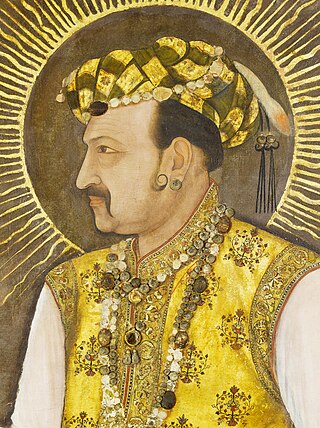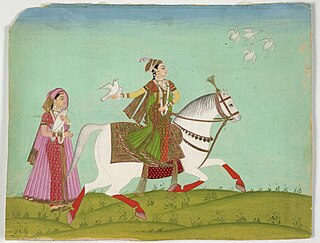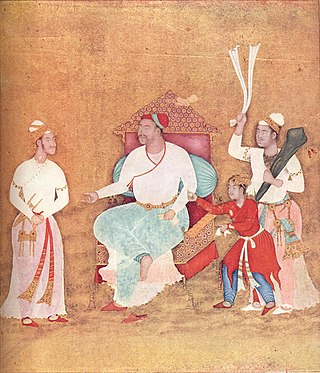Related Research Articles

Nur-ud-Din Muhammad Salim, known by his imperial name Jahangir, was the fourth Mughal Emperor, who ruled from 1605 till his death in 1627.

Mirza RajaMan Singh I was the 24th Maharaja of Amber from 1589 to 1614. He also served as the Subahdar of Bengal for three terms from 1595 to 1606 and the Subahdar of Kabul from 1585 to 1586. He served in the Imperial Mughal Army under Emperor Akbar. Man Singh fought sixty-seven important battles in Kabul, Balkh, Bukhara, Bengal and Central and Southern India. He was well versed in the battle tactics of both the Rajputs as well as the Mughals. He is commonly considered to be one of the Navaratnas, or the nine (nava) gems (ratna) of the royal court of Akbar.

Mariam-uz-Zamani ;, commonly known by the misnomer Jodha Bai, was the chief consort and principal Hindu wife as well as the favourite wife of the third Mughal emperor, Akbar. She was also the longest-serving Hindu empress of the Mughal Empire with a tenure of forty-one years (1562–1605).
Ali Quli Istajlu, also known by his later, given name of Sher Afgan Khan was a Turkoman who initially served the Safavids, and later became a Mughal courtier, becoming the jagirdar of Burdwan in West Bengal (1605–1607). He was also the first husband of Nur Jahan (Mehrunissa), who later married Jahangir after Ali Quli Khan's death and became Empress of India and the power behind the emperor.

The Kingdom of Amber, also known as Kingdom of Dhundhar, and Jaipur State, was located in the north-eastern historic Dhundhar region of Rajputana and was ruled by the Kachwaha Rajput clan. It was established by Dulha Rai, possibly the last ruler of the Kachchhapaghata dynasty of Gwalior who migrated to Dausa and started his kingdom there with the support of Chahamanas of Shakambhari in the 12th century. Mostly through 12th to 15th century, the kingdom faced stagnation, sources were scarce. Under its ruler, Raja Chandrasen Amer became a Sisodia vassal and fought in the Battle of Khanwa under Raja Prithviraj Kachhwaha.

Sultana Chand Bibi was an Indian ruler and warrior. She acted as the Regent of Bijapur Sultanate during the minority of Ibrahim Adil Shah II in 1580-1590, and regent of Ahmednagar Sultanate during the minority of her great nephew Bahadur Shah in 1595-1600. Chand Bibi is best known for defending Ahmednagar against the Mughal forces of Emperor Akbar in 1595.

Raja Bharmal, also known as Bihari Mal, and Bihar Mal, was the 22nd Kachwaha Rajput ruler of Amber, which was later known as Jaipur.

Udai Singh, often referred as the Fat was the Rathore ruler of Marwar, which was later known as Jodhpur. He was also the maternal grandfather of Shah Jahan, the fifth Mughal Emperor, and an ancestor of all subsequent emperors.
The Farooqi dynasty or the Farooq Shahi was the ruling dynasty of the Khandesh Sultanate from its inception in 1382 till its annexation by the Mughal emperor Akbar in 1601. The founder of the dynasty, Malik Ahmad participated in a rebellion against the Bahmani ruler Muhmmad Shah I in his early years. When he was compelled to flee from Deccan, he established in Thalner on the Tapti River. After receiving the grant of the fiefdoms of Thalner and Karanda from Firuz Shah Tughluq in 1370, he conquered the region around Thalner, which later became known as Khandesh. By 1382, he started ruling independently.

The Berar Subah was one of the Subahs of the Mughal Empire, the first to be added to the original twelve, in Dakhin from 1596 to 1724. It bordered Golconda, Ahmandagar, Kandesh and Malwa subahs as well as the independent and tributary chiefdoms to the east.

Narnala Fort or Narnala Qila Sarkar, also known as Shahnoor Fort, is a hill fortress in the Satpura Range of Vidarbh, Maharashtra, India, named after the Rajput Solanki Chaulukya Ruler, Raja Narnal Singh, also known as Narnal Singh Swami. It was renamed as "Shahnoor" by Islamic rulers but again acquired, rebuilt and got its name "Narnala" by ruler Rao Rana Narnal Singh Solanki, who migrated from Patan in Gujarat.

Abu'l-Fath Jalal-ud-din Muhammad Akbar, popularly known as Akbar the Great, and also as Akbar I, was the third Mughal emperor, who reigned from 1556 to 1605. Akbar succeeded his father, Humayun, under a regent, Bairam Khan, who helped the young emperor expand and consolidate Mughal domains in the Indian subcontinent.

Daniyal Mirza was the shahzada of the Mughal Empire who served as the Viceroy of the Deccan. He was the third son of Emperor Akbar and the half-brother of Emperor Jahangir.

Burhan Nizam Shah II was the ruler of Ahmadnagar Sultanate in the Deccan. He was the second son of Hussain Nizam Shah I and Khunza Humayun Begum.

Manavati Bai, also spelled Manvati Bai,, better known by her title, Jagat Gosain, was the second wife and the empress consort of the fourth Mughal emperor Jahangir and the mother of his successor, Shah Jahan.

Murad Mirza was a Mughal prince as the second surviving son of Mughal Emperor Akbar and his mother was a royal concubine. He was raised by Salima Sultan Begum until age of 5. He was the maternal grandfather of Nadira Banu Begum, wife of Prince Dara Shikoh.

Parviz Mirza was the second son of Mughal emperor Jahangir from his wife, Sahib Jamal. His daughter, Nadira Banu Begum, later became the wife of Dara Shikoh.

Sahib Jamal was the wife of Prince Salim, the future Mughal emperor Jahangir and the mother of his second son, Prince Parviz.

The last two Gujarat Sultans, Ahmad Shah III and Mahmud Shah III, were raised to throne when they were young so the nobles were ruling the Sultanate. The nobles divided territories between themselves but soon started fighting between themselves for supremacy. One noble invited the Mughal emperor Akbar to intervene in 1572 which resulted in the conquest of Gujarat by 1573 and Gujarat becoming the province of the Mughal Empire.
Raja Sangram Singh was ruler of Kharagpur Raj in the 16th century. He was a contemporary of Akbar. Sangram Singh initially was allegiance to Akbar, but during the reign of Jahangir, he declared himself independence and was killed during battle with Mughal forces due to assassination. After his death, his son Toral Mal converting to Islam, changed his name to Roz Afzun, became loyal of Mughal and deployed as king of Kharagpur by Jahangir.
References
- 1 2 "Dhulia district gazetteer – history, medieval period".
- ↑ Michael Fisher (2015). A Short History of the Mughal Empire. Bloomsbury Publishing. p. 91. ISBN 9780857727770.
- ↑ Beveridge, Henry (1907). Akbarnama of Abu'l-Fazl ibn Mubarak - Volume III. Asiatic Society, Calcuta. pp. 982, 990, 1063.
- John F. Richards. New Cambridge History of India: The Mughal Empire. New York: Cambridge University Press, 1993. p. 51.
This article needs additional or more specific categories .(October 2023) |